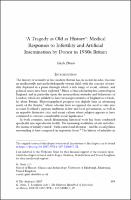Chapter 19 ‘A Tragedy as Old as History’
Medical Responses to Infertility and Artificial Insemination by Donor in 1950s Britain
Abstract
This chapter will explore how the infertile patient was characterized, perceived, and treated by the medical profession in 1950s England and Scotland. Such was the concern that this subject engendered in postwar Britain that a Departmental Committee was appointed in 1958 (known as the Feversham Committee) to investigate infertility and its treatment through artificial insemination. The written and oral evidence submitted by medical witnesses to that Committee offers rich insights into medical thinking and practice, and into the complex sociomedical politics and ethical anxieties which surrounded the topic. The testimony of legal and religious witnesses will also be explored to a more limited extent in order to offer some context to medical understandings and treatments of infertility. It will be considered how women’s bodies, personalities, and even agency in proactively seeking motherhood through artificial insemination were heavily pathologized in medical and religious discourses, but also how the men involved – husbands, sperm donors and even doctors – did not escape this tendency to pathologize.
Keywords
Artificial insemination, Doctors, Infertility, Pathologization, ReligionDOI
10.1057/978-1-137-52080-7_19ISBN
9781137520791, 9781137520807Publisher
Springer NaturePublisher website
https://www.springernature.com/gp/products/booksPublication date and place
London, 2017Grantor
Classification
Infertility and fertilization


 Download
Download